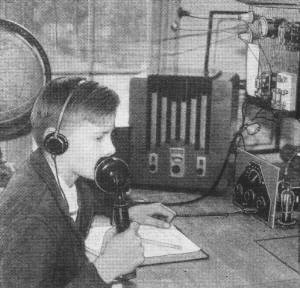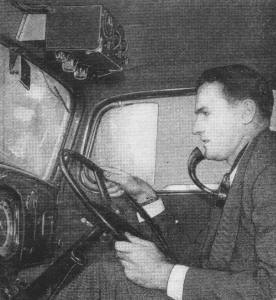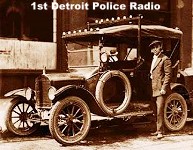Calls Home from Auto by Short Wave
|
|
This could be one of the earliest reports of mobile communications between a private automobile and a home base station. Using a personally designed and installed 5−meter transceiver both at home and in his car, Mr. Wallace is able to talk to his 12-year-old son on the way from work. My guess is that in 1935 there were not too many traffic jams, even in Long Beach, California, so it is doubtful that was the cause for his announced expected later-than-normal arrival home. The article states the automobile power supply needed to produce 300 mA of current at 525 V, which is ~160 W per Ohm's law, which seems unlikely considering car batteries were 6 V at the time, and that would work out to ~26 A. My question is whether little Billy possessed a license permitting him to talk back to dear old dad from the home station? If not, it really doesn't matter at this point since there is probably some statute of limitations that absolves him from prosecution ;-) RF Cafe visitor Dave H. wrote to offer the following additional information about the history of mobile radio communications. It is fairly extensive, so it is posted at the bottom of the page. Calls Home from Auto by Short Wave The home station has a 1 kw C.W. and phone transmitter operating on 10, 20, 40, and 80 meters. Don Wallace talking from car. Don C. Wallace of Long Beach, California calls up his home daily on 5 meters, using the apparatus shown in the accompanying photos. His car is fitted with a 5−meter 2−way radio set, so that he can talk to his home and hear the folks when they talk to him. In the event that he is away on a trip 20 miles or so from home and finds that he will be home late, he can close a switch with his foot which will start his 5-meter transmitter going and he then calls his home. His 12−year−old son, Bill, stands watch everyday at 5:30 p.m. By kicking the floor switch in the opposite direction, the 5−meter receiver is set into operation aboard the speeding auto and Don Wallace can then hear his son's voice and the "family news" of the day. Mr. Wallace tells us that the set on the car works as well at high speed as it does when standing still. The main parts of the transmitter are located under the hood of the car. Twelve-volt storage batteries supply the primary current for the motor-generator, which delivers 525 volts with 300 M.A. The antenna on top of the car is a 5−foot vertical steel fishing rod; This is hinged so that if any object such as a tree should hit it while the car is speeding along, the pole will merely bend. This antenna works against a 3−foot counterpoise which extends forward and down toward the hood. The entire 5-meter transmitter and receiver is relay−controlled, a foot-operated switch on the floor serving to operate all of the relays.
Posted June 10, 2020 |
|



